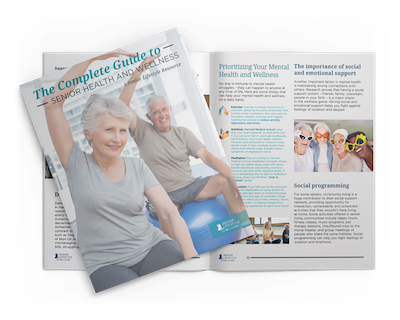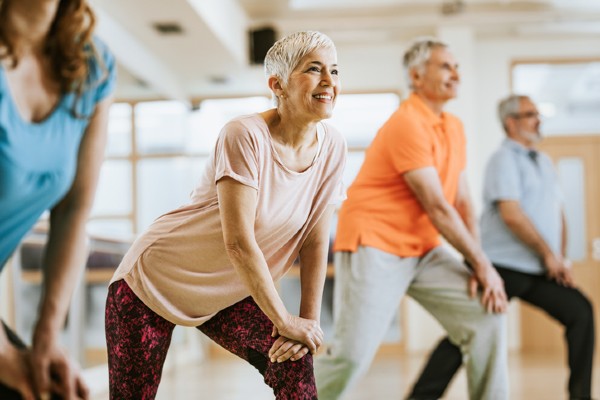Feeling safe and staying independent as a senior is important to both yourself and to the people who care about you. One of the most common safety considerations for seniors happens to be experiencing a fall. According to the U.S. Centers for Disease Control and Prevention, 14 million adults ages 65+ experience a fall each year. Though not every fall leads to an injury – even a small slip or trip can feel unsettling.
The good news is that many falls can be prevented in the first place.
Whether you’re considering care options for a loved one or planning for your own well-being, understanding fall prevention for seniors is a vital step. In this blog, we’ll explain how to prevent falls as a senior, what a fall risk assessment includes, and offer simple, effective fall prevention tips for seniors that you can start using today.

Download The Complete Guide to Senior Health and Wellness
The key to living your “best life” as you age? Prioritizing your health. Check out our eBook, “The Complete Guide to Senior Health and Wellness,” to learn about the most important aspects of senior health and wellness.
Download the GuideFall Prevention Tips For Seniors: 7 Effective Strategies
Many simple actions can significantly reduce the chances of a fall. These fall prevention tips for seniors are a great place to start:
1. Prioritize Physical Exercise
As a senior, gentle, regular movement can help maintain muscle strength, flexibility, and balance. Simple exercises like walking, water aerobics, chair yoga, and tai chi have also been shown to improve coordination and lower fall risk. For those who experience limited mobility, it can be helpful to ask a doctor or therapist about seated exercises that can be done at home.
2. Schedule Routine Vision and Hearing Exams
Vision and hearing both play a major role in our overall navigation and balance. Seniors or their caregivers should make sure eyeglass prescriptions are current and that hearing aids, if used, are functioning properly. This is important, as visual and auditory impairments have been linked to missed steps or unseen hazards.
3. Review Medications With a Professional
Seniors should have all of their current medications, including over-the-counter supplements, reviewed by a healthcare provider. This is important, as some drugs may interact in ways that cause drowsiness or dizziness, which could increase your risk for falling. Stability may be improved with dosage changes or alternative medicines that do not include these side effects.
4. Make Your Home Safer
A senior’s home should be a place of comfort – not risk. Every room in your residence should be regularly evaluated for potential fall hazards. Prioritize making the following small changes first for added safety:
- Add grab bars near toilets and inside of your shower
- Place non-slip mats in bathrooms and kitchens
- Keep pathways clear of clutter, cords, and throw rugs
- Use nightlights in hallways, bedrooms, and bathrooms
- Consider a chair lift or ramp for staircases for added support
5. Wear the Right Footwear
Even at home, supportive shoes with non-slip soles are much safer than slippers or walking in socks. You should look for shoes that fit well, stay securely on the feet, and provide a good grip on different floor surfaces.
6. Stay Hydrated and Nourished
Did you know that dehydration and low blood sugar can cause dizziness or fainting? Regular meals throughout the day and hydration can help keep energy levels steady.
7. Consider Using Mobility Aids
The use of a walker, cane, or other assistive devices can make a positive impact, supporting seniors in moving more confidently and with added stability. A physical therapist can help provide guidance on proper use.
Why Fall Prevention Matters
Falls can happen to anyone, but seniors face unique risks due to natural changes that occur with aging. A single fall has the ability to result in an injury, but a slip can trigger a fear of falling again, which can lead to reduced activity. Over time, this fear can increase isolation, weaken muscles further, and ultimately raise the risk of future falls.
This is why focusing on methods of fall prevention is key. With a proactive approach, most falls can be avoided – protecting your quality of life. This helps to ensure you continue to live your life, your style, without compromise.
Common Risk Factors for Falls in Seniors
Falls are rarely caused by just one thing. Instead, they often happen due to a combination of internal and external factors. These may include:
- Balance or gait changes: Seniors experience natural changes in coordination or strength, which can impact stability when walking or standing.
- Muscle weakness: It can sometimes be more challenging for seniors to get up from chairs, climb stairs, or catch themselves during a stumble. This often stems from reduced muscle tone, particularly in the legs and core.
- Vision and hearing changes: Blurred vision or reduced depth perception is common in seniors, making obstacles harder to spot. Difficulty hearing can also affect balance and awareness of surroundings.
- Medication side effects: Seniors can experience dizziness or lightheadedness because of some medications, including those for blood pressure, sleep, or anxiety.
- Chronic health conditions: Conditions common to seniors including diabetes, arthritis, or Parkinson’s disease may affect movement, balance, or energy levels.
- Environmental hazards: Pathways should be kept clear, because slippery floors, loose rugs, dim lighting, or cluttered pathways can all increase the risk of tripping or slipping at home.
What Is a Fall Risk Assessment?
A fall risk assessment is a way to evaluate someone’s likelihood of falling and identify steps to improve safety. These assessments are often done by healthcare professionals, such as physical therapists, nurses, or doctors, but family members can also use basic observation tools at home.
A typical fall risk assessment may include:
- A review of a senior’s medical history and medications
- An evaluation of their walking ability, strength, and balance
- A check of senior vision and hearing
- A home safety review for trip hazards or accessibility
Some senior living communities also offer free fall risk screenings as part of their wellness services. These assessments identify risks and help to create a personalized prevention plan.
When at Home Prevention May Not Be Enough
Despite taking precautions, some seniors may still experience a fall. In these cases, a senior living community may offer the right mix of independence and support.
Communities focused on fall prevention for seniors, such as Senior Lifestyle, often feature:
- On-site wellness programs
- Trained care teams available 24/7
- Emergency response systems in every room
- Slip-resistant flooring and accessible layouts
- Group exercise and strength-building classes
Having a supportive environment can remove much of the stress and uncertainty for both seniors and their families.
A Safer Future Starts with a Conversation
If you’re noticing changes in your or your loved one’s mobility, strength, or confidence, now is a good time to find a Senior Lifestyle community near you or request a fall risk assessment from your doctor. Fall prevention starts with awareness, but it leads to so much more: independence, comfort, and a greater sense of control.
If you’re seeking a welcoming place that offers comfort, connection, and peace of mind, we invite you to visit a Senior Lifestyle community near you. Whether you’re looking for Independent Living, Assisted Living, or personalized Memory Care in our Embrace Neighborhoods, you’ll find a place where a senior’s safety is a priority and comfort, care, and connection come together.
Find out more about Senior Lifestyle or schedule a visit today!

